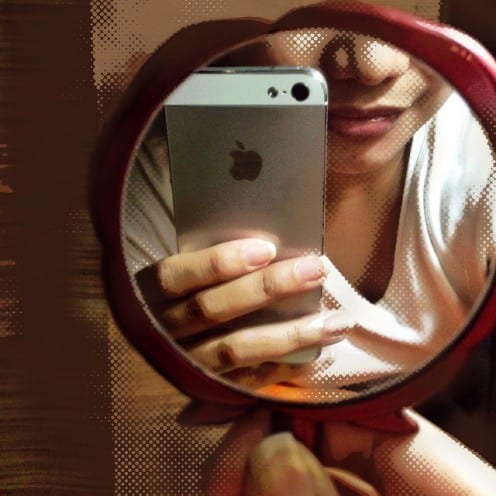Know thy selfie
By Daniel Miller, on 1 April 2014
As noted by last week’s The Economist it seems that every new cultural development is assumed by both journalists and academics to be a sign of our growing superficiality and especially our narcissism. A primary use of Anthropology has been to bolster the idea that it is `other’ societies that represent authenticity and depth. I have lived in tribal and peasant societies and I do not accept that my fellow Londoners are either more superficial, or more narcissistic, or even that they are more concerned with the public appearance of the person, than would the case for most other societies studied by anthropologists. It is no surprise that the most recent `proof’ of this narcissism is held to be the Selfie, presumed to be a key moment in growing infatuation with our own appearance. But once again I think it is the interpretation of the Selfie, not the Selfie itself, that should be condemned as merely superficial. To equate the Selfie with narcissism is to imply that it is an idealised version of the self, directed at the self. This is surely mistaken.
The Selfie is clearly aimed at others, placed on social media as a form of communication. What is a Selfie without its `likes’? As a school pupil put it:- `But it’s sort of while you are having a conversation, you just send a picture of yourself.’ It is literally a `snap-chat’. More importantly the Selfie is subject to polymedia and cultural variation. With respect to polymedia, the `classic’ young, female, pouting, dressed to party, pose has become strongly associated with Instagram. But there is a whole other genre that is found on the much larger platforms of Snapchat and WhatsApp. For young people in England by far the most common form of Selfie is an image designed to make oneself look as ugly as possible. One common pose is with the camera taking the face from below the chin, right up the nostrils. It is predominantly the same young people who create the Selfie that create this `Uglie’. Many more Uglies are posted that Selfies, but most discussions entirely ignore the more prevalent image. Adults often create a similar dualism, but vicariously. Look at the endless postings of their babies, either highly idealised, or looking as ridiculous as possible. These are not individualistic, rather today they have become highly normative forms. The Uglie relates to English humour and self-deprecation rather than being a universal form and thereby reflect cultural specificity. The single term Selfie also fails to differentiate adult Selfies from teenage usage, the increasingly common group Selfie from the individual. It also ignores the difference between all of these and what might be termed the `meta-Selfie’ where the image is of a person taking a Selfie through the mirror. These are often taken simply because they are a more effective way of showing the whole outfit that an individual is wearing. But at least in the English context they can also become a visual comment, ironic or otherwise, on the taking of the Selfie.
There are even more reasons for taking Selfies than there are genres, and of course, a Selfie can be superficial. I don’t especially admit a tradition in cultural studies that enjoys taking something denigrated as superficial and then making some pretentious claim for its deep significance. But a recent encounter with a Selfie helped me appreciate that the Selfie certainly has that capacity for depth and profundity. This Selfie is the cover photo for the Facebook profile of someone I interviewed as part of my hospice research. One of the main reasons that people dying of cancer retreat into isolation is that they don’t want others to see the devastation to their own appearance that often comes with chemotherapy, if not from the cancer itself.
The physical disfigurement is itself debilitating. This forty-two year old even kept his girlfriend away during chemotherapy which had been particularly gruelling and destructive in his case. After the chemotherapy ended he began to put back on some weight. He once again started to look like himself. After six weeks he decided to take precisely that kind of Selfie that is posed in front of the mirror. The stance and facial expression are clearly assertive. As he makes clear he first had to acknowledge to himself that he could once again become a decent human being and only then could he communicate this to others. The distance between knowing something as an external fact and internalising it as an acknowledged truth is circumvented because this particular kind of Selfie can operate on both of these modalities simultaneously. Prior to the existence of this form of Selfie it is unlikely that there is anything he could have done that could so succinctly have communicated to others that he had acknowledged the change in himself to himself.
In this instance I found myself drawn back to the writings of Sartre whose work on existentialism directly equated issues of self-expression to the freedom to choose the nature and manner of our death. More generally the Selfie seems to fit arguments made by the sociologist Anthony Giddens about self-identity. It is not that we are more obsessed by our public appearance. Compared to say the characters in the world’s first novel from the 11th are almost relaxed. As argued in my and Jolynna’s recent book Webcam, what has perhaps changed is our self-consciousness about this concern with appearance, and therefore the need to not only cultivate our looks, but to simultaneously comment upon that act of cultivation, that suggests we know what we are doing. In England this is ideally done with irony and the Selfie only makes sense when we also include the Uglie in our analysis. But the Selfie can be also a serious and evidently in some cases literally a life-affirming use of a new visual genre that exploits it’s very specific form of self-revelation.
 Close
Close





